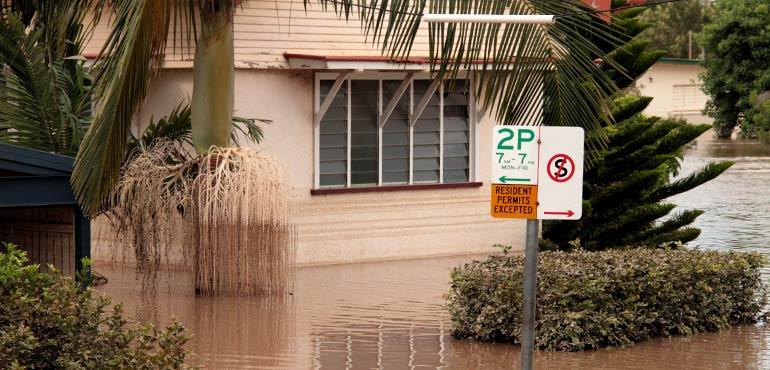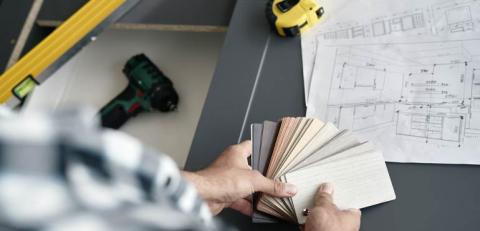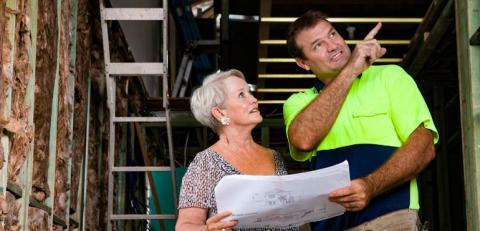
- Home
- Your property
- Storms and natural disasters
- Recover from natural disasters
Recover from natural disasters
After a disaster, there can be a lot of work to do.
We have some general tips to help you when returning to your property after a disaster.
- Ensure the property is safe.
- Lodge a claim with insurance (if you have it).
- Safely clean up debris. Wear protective equipment and if there is asbestos, get a licensed professional to clear and dispose of it.
- Only use QBCC licensed contractors for repair work, so you have cover with the Home Warranty Scheme and access to our dispute resolution service. To find contractors not regulated by the QBCC such as electricians, asbestos removalists or demolishers, contact the specific regulatory bodies such as:
- Make sure you have a written contract for the repairs.
- The QBCC has a natural disaster repairs contract (PDF, 702KB), designed for repairs after a natural disaster.
- If a home needs to be demolished, the standard demolition contract (PDF, 347KB) can be used.
- You can read more on our Contracts and payments pages.
- Check if you need a building permit. A QBCC licensed certifier can provide permits, if required, as well as approving the building work.
Resources to help you recover
These general resources could help after a natural disaster:
The Queensland Government has a number of fact sheets and website pages that will help you in the immediate aftermath of fire:
These resources may be helpful after a flood:
Find out more about what to do after a cyclone:
If you need financial assistance after a disaster, there may be resources to help you:
If your property has been damaged by a natural disaster, these resources may help:
The QBCC recommends owners of older buildings arrange a professional building inspection of the roof framing after a cyclone. This is to ensure there is no damage or partial failure of the framing/tie-down elements.
James Cook University's Cyclone Testing Station (CTS) damage assessments of buildings affected by cyclones have shown that older houses and business premises can sustain hidden damage. This damage can't be seen from the outside, only when an internal inspection of the roof space is completed.
If you have any of the following issues, they may indicate the need for further investigation:
- movement, or spongy-feeling roof coverings when walked on
- excessive squeaking when the roof is walked upon
- gaps evident between roof battens and rafters or trusses
- loose roofing screws or nails.
If your roof requires repair work, such repairs must meet current building codes and improve the strength and resilience of the roof framing of your home. This will better ensure its performance during future high-wind events.
If your home has been damaged
If your home has been damaged in the South East Queensland floods or bushfires, our registers will let you search for licensed contractors who can help with repairs to make your home safe and habitable:
Frequently asked questions
Cleaning up after a disaster
Visit disaster.qld.gov.au to see the details of any evacuation centres nearby or call the Community Recovery Hotline on 1800 173 349 for advice.
You can contact your local government or community associations such as Rotary, Red Cross, Apex, Salvation Army or Lions. Home Assist Secure can also help communities. You can also search the internet for volunteers in your area.
- Residents should take green waste to their local transfer station.
- Other waste disposal options such as kerbside collections will usually be organised in disaster-affected areas.
- Home owners can contact their local government for suburb specific and current information.
Asbestos
Properties built before 1990 are likely to have asbestos containing materials, which can appear in many different forms. Do not attempt to remove this material yourself, and do not disturb or break it as asbestos fibres may be released.
If you think there may be asbestos in your home, call your local council or Workplace Health and Safety Queensland on 1300 362 128. More detail on asbestos safety can be found on the WorkSafe website.
Workplace Health and Safety Queensland licence specialists who remove asbestos. For a list of licensed asbestos removalists visit the WorkSafe website.
See our web page learn more about:
Timber safety
If cleaning up areas where copper chrome arsenate (CCA) treated timber has been burned, be aware it can pose a health risk if only a few grams are swallowed or inhaled.
It is not possible to tell if ash contains arsenic just by looking at it, so you should treat the ash as containing copper, chromium and arsenic.
You should:
- wear personal protective clothing while cleaning up
- keep children and animals away from the area
- moisten the ash before moving it
- double-bag and seal the ash for disposal in landfill
- Call HEALTH (13 43 25 84) at any time for more information.
Electrical safety
If a house or business has been damaged, electrical equipment, wiring and appliances may have been affected. Using water damaged equipment can result in electric shocks and fines.
The Electrical Safety Office recommends disposing of small household electrical items such as kettles and toasters, rather than risking an accident.
A licensed electrician should inspect any larger appliances such as televisions and refrigerators which may have been in contact with water.
Master Electricians Australia will have a list of contractors who can help the community.
For more information, contact:
- Energex (13 12 53) for south east Queensland
- Ergon Energy in other areas of Queensland
- Electrical Safety Office.
To ensure safety, you should turn the power off and contact your electricity supplier.
Stay clear of fallen powerlines. For powerlines down, phone:
- Energexon 13 19 62 (south east Queensland)
- Ergon Energy on 13 16 70 (all other areas in Queensland).
Water and waste safety
- If your rainwater tank was not disconnected before the fire, pipes should be disconnected or redirected as soon as it is safe to do so.
- Clean your roof and gutters thoroughly (do not use a pressure washer if you have an asbestos roof), then reconnect rainwater pipes.
- If you have a firstflush device, ensure it is empty and in good working order.
- If it has rained since the bushfire and collection pipes were connected, it is likely that ash and other contaminants will have flowed into the tank. In most cases, your tank will need to be drained and cleaned, and re-filled using a water source that is safe for drinking. As this work can be hazardous, the QBCC encourages the use of suitably qualified contractors.
If you notice any change in the quality of water (including colour, cloudiness or smell), stop using the water immediately and contact Queensland Health on 13 HEALTH (13 432 584) for further advice. You may also wish to contact your local government to arrange water testing.
If your property has been directly affected by fire, there are some steps you should take to ensure safety relating to your on-site sewerage facility.
- Rope off the area where your facility is installed, as the tanks may be damaged from fire and could lead to falls.
- If your facility has failed or been inundated with water from fire-fighting efforts, it could lead to sewage backing up in the system.
- If your home is contaminated, abandon the building until it can be thoroughly cleaned and sanitised.
- Avoid flushing disinfectants down the drain, as these can impact the operation of the facility.
- Reduce water use until you have the system inspected by an appropriately licensed contractor and repaired if necessary.
Starting repair work
It will depend on the nature and extent of the work required. To ensure your responsibilities as a property owner or contractor have been met, it is recommended that you contact your local government.
You can use our Find a local contractor search. The search allows you to choose a category of building work and select a kilometre radius from a postcode. This will provide you with a list of local contractors who may help with repair work.
If a contractor has given you a quote, you should also ask for their QBCC licence number to check our website if they are licensed for the work. A tradesperson must be licensed for any building work valued at over $3,300.
Insurers will either recommend obtaining at least 2 written quotes or will arrange quotes themselves. Talk to your insurer.
Yes. A contract is a legal requirement for all work valued over $3,300. We also strongly recommend entering into a contract for work valued at less than $3,300, but this is not a legal requirement.
You should also confirm that your contractor holds the appropriate licence for the work.
The work you and the contractor agree upon should be fully described in the contract to prevent any misunderstandings and minimise the risk of potential disputes between you and your builder.
Any variation to the contract should be in writing, signed by both you and your builder, and attached to the contract.
Variations should describe not only the work but also record any agreed price changes. A contract must:
- be signed and dated by you and your builder
- contain your name and your builder's name
- contain the site address
- contain the builder's licence details
- state the start and completion times
- state the payment arrangements
- have the plans and specifications attached
- contain the statutory warranties
- display the total contract price.
You need to contact an appropriate tradesperson for repairs. Depending on the extent of the damage, this should either be a licensed Structural Landscaper or Builder.
You may also need the services of an engineer. Contact the Board of Professional Engineers Queensland for more information.
Insurance
Each insurance policy is different depending on various factors, such as the location of the insured property and the insurer issuing the policy. You must read the policy and make sure it covers all of your requirements. If you are unsure, contact your insurer to provide answers specific to the policy and you.
You will need to confirm this with your insurer, however, contents insurance generally covers items in the home such as furniture, clothing and electrical goods.
Uninsured people may be able to access financial assistance through the Queensland Government. Assistance is subject to an income and assets test. Call the Community Recovery Hotline on 1800 173 349 for more information.
If you are unhappy with an insurance assessment or service, you will need to read your insurance contract and talk directly to the company to try to resolve the problem.
For more information, claimants can contact:
- Insurance Council of Australia on 1300 728 228
- Australian Financial Complaints Authority on 1800 931 678
Your contractor should present you with a written contract and explain how and when they intend to do the work. If you have any concerns about the conduct of your contractor, contact the QBCC on 139 333.
Yes. Licensed contractors must obtain home warranty insurance on all residential construction work over $3,300 in value. Find out more about what home warranty insurance covers.



